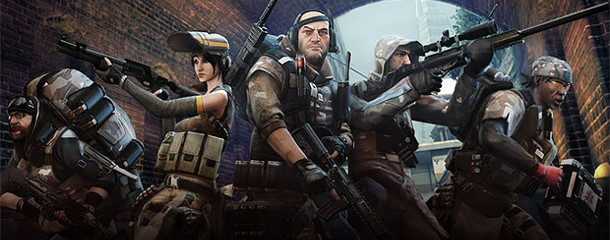Dirty Bomb is a first-person team-based shooter with a strong emphasis on objectives and teamwork. Each match can have between 10 to 16 players, with smaller team sizes preferred for competitive play and larger ones for casual play. One team is the defenders, and one is the attackers. The attackers try to complete objectives on the map, and the defenders try to stop them.
The game is unfortunately no longer being actively developed, and has only a small player base of a few hundred veterans and some newbies, but it is still playable.
Official website: https://www.dirtybomb.com/
Steam page: https://store.steampowered.com/app/333930/Dirty_Bomb/
Elemental Tetrad
Mechanics
- First person team-based shooter.
- Objective-based gameplay.
- Character classes and abilities.
- Advanced movement mechanics such as long jumping, double jumping and wall jumping.
Story
- London is attacked with dirty bombs, and the Central Disaster Authority is created to deal with the fallout. A criminal group called Jackal starts disrupting their efforts and stealing valuable technology, leading to both sides hiring mercenaries to serve their interests.
- Nothing special, there is not much emphasis on the story in the game itself. Some snippets are mentioned sometimes in cutscenes before and after matches, and some map assets are themed, but besides that the focus is on gameplay.
Aesthetics
- Modern London, with some maps based around landmarks such as the Bank of London and the London Victoria station.
- Each character has a distinctive silhouette and look, which improves visibility and also looks good.
- Some objects are themed after the story, such as an escortable armoured vehicle being painted with the colours of one of the factions.
Technology
- Windows 7+.
- Unreal Engine 3.
- Requires a decent graphics card and CPU due to the game not being well optimised.
Lenses
Lens of Cooperation

Players can choose from a variety of mercenaries from the five classes: engineer, medic, fire support, assault and recon.
Each class is superior to the others in one aspect of the game, such as engineers completing objectives faster, and fire supports being able to resupply ammo and call in wide-area attacks for damage and area denial. All serve an important role, and a balance of classes must be present or the team is much less likely to win.
In the competitive scene, almost every team had 2 medics and 1 engineer at all times, with the other 2 slots being taken up by assaults, fire supports and recons depending on the map and the game state. For example, on the defending team, they might take an assault and a fire support in order to increase their firepower and have area denial capabilities. On the other hand, the attackers might take a recon in order to pick off the defenders safely before moving to do the objective.
Additionally, cooperation is facilitated via the quick chat system. Players can press ‘V’ to bring up a list of callouts, ranging from greetings, to asking for ammo, to taunting the enemy team. This allows players to simply quickly press a few buttons to instantly provide their team with information. For example, the keypresses V-2-1 results in a call for a medic in text chat as well as causing your character to call out.
Lens of Skill
Dirty Bomb is a skill-based game. Players must cultivate many skills such as movement, aim, timing and situational awareness, to name a few. All these skills are needed in order to become good at the game. To give an example, a player who simply runs to the objective will arrive slower than another who uses wall-jumping to boost their speed. Similarly, some shortcuts or spots on the map can only be accessed via advanced movement mechanics.
Dirty Bomb has a respawn system that is not commonly seen that adds an additional layer of complexity to the game. Instead of individual players having a death timer, such as needing to wait 3 seconds before respawning, there is a team-wide timer that constantly ticks. At the end of the timer, everyone downed or dead on the team can respawn in what is called a “spawn wave”.
Spawn waves affects the flow of the game, as players cannot rush blindly into combat or they risk being stuck waiting to respawn for a long time. Good players can take advantage of this system. When there is a long time before the next spawn wave, they play more defensively, and when the spawn wave is due in a few seconds, they push aggressively so even if they die they can be back in the action nearly instantly. Also, due to this system, if a player knows the enemy spawn wave timer, they can call down an airstrike just as the enemy leaves their spawn and loses their spawn protection, giving their team an advantage in the next fight.
Lens of Balance
While there are a few outliers at top-level play where communication is constant and relevant, at lower levels of play the roster of mercenaries is remarkably balanced. Each mercenary has their own strengths and weaknesses, and has counterplay to their abilities. For example, one medic can put up a dome-shaped shield that destroys all incoming projectiles such as grenades and artillery strikes, but the shield is easily destroyed by gunfire.
Looking away from character abilities, the weapons are mostly balanced well and are meaningful sidegrades to each other instead of upgrades. Also, all mercenaries are competent in combat, with even medics being able to take down assaults with proper positioning, ability use and aim.
Lens of Parallelism
Each objective has side objectives that make it easier to attack the main objective and prevent. For example, the attacking team might try to destroy a generator to open up an alternate path to the main objective. On the flip side, the defending team has to decide if they want to allocate resources to preventing this from happening. This adds further depth to the game.


/HLS19_HoloLens2_leftFacing_tilt_RGB_4K_whiteBG-d17efed754084023912d029033bc378f.jpg)